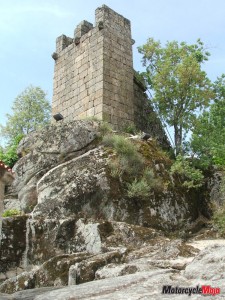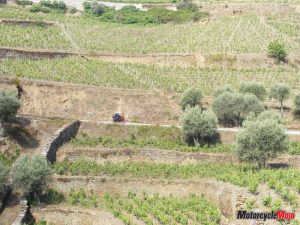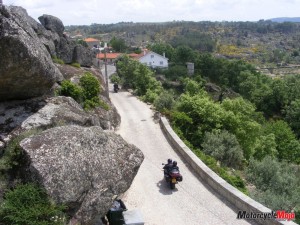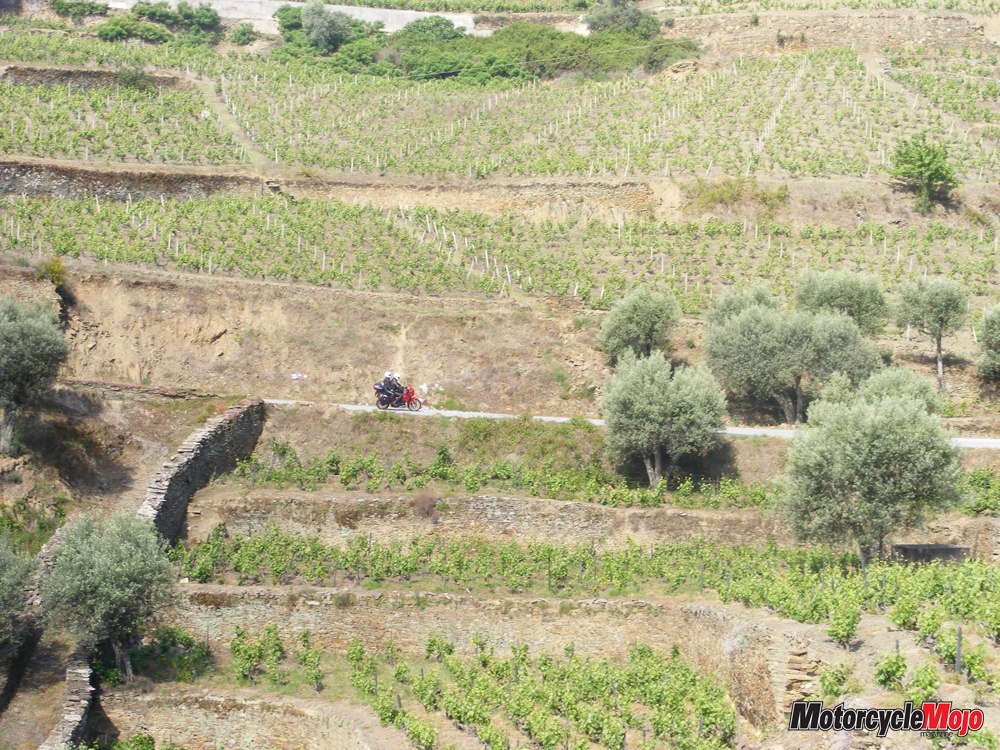Stray ostriches and fine port take a back seat to a rich history, decadent accommodations and amazing roads.
Dipping a wing over the Atlantic, our pilot sweeps inland over a sea of terracotta roofs into Lisbon, Portugal. After landing, my wife, Tina, and I wait for Judy, our friend and riding partner, who arrives later on a flight from Toronto. We squish into a taxi, and when our driver learns that the purpose of our journey is to spend seven days touring Portugal by motorcycle, he excitedly tells us in broken English all about his brand-new Suzuki Hayabusa. Driving with one hand and gesturing with the other – weaving from lane to lane, careening around corners, and jockeying for position on roundabouts – he delivers us to our hotel. There, Jeff and Debbie and Tom and Dianne, also our riding partners, are waiting. Together we spend the night in anticipation of our first-ever European motorcycle tour, led by Motocadi owner Julian Cade, who hosts tours of Portugal, Spain, Morocco and Scotland. Our tour, “The Spirit of Portugal,” will introduce us to the unique roads and hospitality of Portugal.
 The following May morning dawns sunny and warm, and Julian arrives right on time at our hotel on his Trans Alp followed by a taxi towing a trailer for our luggage. We head up the autoroute, behind Julian and Judy on her Suzuki 750 rental, to Obidos on Portugal’s Silver Coast, where the rest of our bikes are waiting. Casa d’Obidos, our overnight accommodation, sits on a promontory that offers a majestic view of orange and olive trees across the valley. In the distance, rising majestically from the valley floor and crowning a high, rocky outcrop, sits the ancient castle and walled city of Obidos. This seventh-century Moorish castle stands silhouetted, serene and austere against the cloudless blue sky, just as it has for over 1300 years.
The following May morning dawns sunny and warm, and Julian arrives right on time at our hotel on his Trans Alp followed by a taxi towing a trailer for our luggage. We head up the autoroute, behind Julian and Judy on her Suzuki 750 rental, to Obidos on Portugal’s Silver Coast, where the rest of our bikes are waiting. Casa d’Obidos, our overnight accommodation, sits on a promontory that offers a majestic view of orange and olive trees across the valley. In the distance, rising majestically from the valley floor and crowning a high, rocky outcrop, sits the ancient castle and walled city of Obidos. This seventh-century Moorish castle stands silhouetted, serene and austere against the cloudless blue sky, just as it has for over 1300 years.
The pre-ride meeting is scheduled for this evening, giving us the day to familiarize, acclimatize and wander the narrow, steep, cobblestone streets of the walled city. Everything is pristine and draped in lush, green foliage and the deep hues of flowers of every description. Vintage grape vines, fifteen centimetres in diameter, hint at the age of the greenery suspended on walls and over patios.
We take a brief tour of a church that features intricate scenes emblazoned on ceramic-tiled walls and ceilings, giving a brief glimpse into its history. The images reveal an age that we in the new world cannot fathom; we measure the age of structures in hundreds of years, but here, the measurement is in thousands.
At our pre-ride meeting at Casa d’Obidos’ poolside, we meet Herman and Sandra, who have just arrived from England with their Triumph Tiger. Having lived in Portugal for several years, Julian is a connoisseur of the local food and wine and takes us to a friend’s restaurant for our first fine-dining experience.
Day two – the ride begins
In the morning, we prepare for our first day’s ride of 370 km. After riding a Gold Wing for years, the Triumph RS 955 Sprint triple is a rather pleasant surprise. (The last Triumph I rode was a Bonneville in the 1960s.) We follow Julian onto the autoroute and he sets a progressive pace, but with almost no traffic on the highway, the speed soon picks up. When we pause at a rest stop, Tina informs me that if we are going to continue at this pace, she would prefer to go back home. This is her first ride of the year and also her first ride on a sport-touring bike, and the combination has caused her some anxiety. I assure her that it will get better. We tuck in behind Tom and Jeff as we get off the highway and venture into Portugal’s hinterland of twisting, turning, two-lane heaven.
Suddenly, up ahead, we see several oncoming cars parked on the road and a man dashing toward us, waving his arms and chasing something rather large and gawky. We slow to a stop and stare, jaws dropping open. I can’t quite believe what I’m seeing: an ostrich running full tilt along the road. Julian rushes to pop open his trunk and retrieve his camera, and I turn to a wide-eyed Tina and say, “Now I have truly seen everything.”
Runaway ostriches give way to rolling hills and tree-lined valleys, with the occasional glimpse of the Serra da Estrela (Mountain of the Stars), and I wish we had more time to take in the views. However, riding in the mountains on strange roads is not recommended after dark, so we motor on, braking hard and leaning into the corners at ever-increasing angles. The only difficulty of riding two-up is that Tina slides forward against me when I brake hard. Later, Tina admits to muttering a lot of prayers during the day’s ride.
The scenery changes to smooth-barked eucalyptus trees and huge boulders strewn about the mountain washes. The roads twist back and forth, always demanding my full attention and respect. I’ve been right behind Jeff and Tom, and they both wave me on as I slip in behind Julian on his Trans Alp. On strange roads, it’s a definite advantage to have a good rider in front who is familiar with the area and knows what line to take on each corner. I process his moves to estimate my own speed, braking and line.
At Torre – the top of Portugal, and 2000 metres elevation – it’s cooler. Amidst the final remnants of the winter’s snow, we take in the magnificent view. On our descent, Julian suddenly pulls over and points to the left at a set of steps, hand-carved into the granite slope leading up to a statue of the Virgin Mary. This craftsmanship and evidence of devout Portuguese Catholicism is everywhere we go. Soon after, Manteigas comes into view at the end of the Zezerre Valley nestled against the Serra da Estrela. It’s about 5 p.m. and we’re tired, but we’ve made good time today.
The slippery, cobbled street leading up to the parking area is so steep that the ladies have to dismount so that we can safely make it up the grade to park the bikes at Casa das Obras, an eighteenth-century manor house. Our hostess, Countess Maria Ameilia Carril de Matos Maderia de Portugal, is a direct descendant of the original owner.
Day three – valleys and mountains
 The next morning, we gingerly make our way down the slippery cobblestones and set out on a 320 km ride to the famous Douro Valley. The demanding roads have established a pecking order, and I follow right on Julian’s back fender. His Trans Alp is about 300 cc less than my Triumph, but I have two saddlebags, a trunk and a passenger, so the match is probably even. I am now accustomed to the Triumph, and scrubbing my toes in the corners has become routine. My personal challenge is to strike the perfect line in every corner but not to use the same line as Julian. I do this whenever I ride with others, a tendency likely left over from my racing days. Striking a different line from the leader also lends me a better view of what’s ahead.
The next morning, we gingerly make our way down the slippery cobblestones and set out on a 320 km ride to the famous Douro Valley. The demanding roads have established a pecking order, and I follow right on Julian’s back fender. His Trans Alp is about 300 cc less than my Triumph, but I have two saddlebags, a trunk and a passenger, so the match is probably even. I am now accustomed to the Triumph, and scrubbing my toes in the corners has become routine. My personal challenge is to strike the perfect line in every corner but not to use the same line as Julian. I do this whenever I ride with others, a tendency likely left over from my racing days. Striking a different line from the leader also lends me a better view of what’s ahead.
We enter a tiny hamlet called Belmonte, high on a hill. Belmonte Castle was the home of Pedro Alvares Cabral, a sea captain and explorer, who sailed across the Atlantic to be the first European in Brazil. The castle was built in 1266, the same year that Marco Polo arrived in Beijing, China. From Belmonte, we head down the winding cobblestone streets to another medieval village. Sortelha, a walled fortress, was built to protect Portugal from Spanish aggressors. No vehicles are allowed, so we walk past the village’s collection of terracotta roofs crowning homes of stone to explore the town, climbing stairs carved out of the solid bedrock that pervades the landscape.
Leaving Sortelha, the serpentine roads climb and twist up to 1000 metres before winding down into the Douro Valley. As the Douro River comes into view, the steep hills on either side of the mountains are held back by stone retaining walls that enclose terraces of continuous vineyards punctuated with the deep green of olive orchards.
In the tiny village of Pinhão, we cross the river and follow the narrow, one-lane roadway that hugs the cliffs and ascends steeply from the valley floor; on our left is a limitless, unobstructed plunge to the river far below. Ten minutes later, we stop in front of a grandiose villa, gleaming white in the early afternoon sunshine and capped with yet another terracotta roof. Casa do Visconde de Chancelieros, our home for the night, is a veritable Garden of Eden to our hot, tired bodies.
Our balcony overlooks the courtyard, with its abundant flower gardens, swimming pool, hot tub, sauna made from a massive wine barrel, and million-dollar view of the Douro Valley. We enjoy an afternoon of total, decadent relaxation, drawn to a close with a meal on the glass balcony of the dining hall, suspended high above the river.
Day four – the land of port
We retrace our steps down the narrow, terraced road and across the river. Today we travel along the river through villages with magical-sounding names – Peso da Regua, Boa Vista, Resende, Ribadouro – all the way to Porto. The roads involve more technical riding with hard braking and accelerating to the next turn. Houses sit so close to the road that many 90-degree turns literally wind through people’s front yards. The houses cling to the steep cliffs along roads that take the path of least resistance through the mountains. Millennia ago, these roads were trails and ox-cart paths that gradually morphed into what are now some of the best motorcycling roads in the world.
The fragrance of another eucalyptus grove sweeps across my sinuses, alerting me to the possibility of calamitous shards of slippery eucalyptus bark on the roadway. Soon, Porto – or Oporto, as the Romans originally named it – comes into view, as cityscape replaces the many winery estates. This ancient city is the birthplace of port wine, and has always been a prosperous trading hub. Across the river, lined with port boats, sits Villa Nova de Gaia, where most of the world’s port originates. Here we tour the W&J Graham Port Company, founded in 1820 and still owned by the same family. Overlooking the sea is the medieval fort São João do Foz, right across the street from the Boa Vista Hotel, once a Franciscan monastery, where we will stay tonight.
Day five – technical riding
 Dark, pregnant clouds loom over the dawn of day five, and we desperately hope it won’t rain. Today we ride the N227, the high point of the tour. Our luck holds. The N227 is indeed a technical, tricky stretch of road. It’s not a high-speed road, but with trees on both sides and blind corners exiting uphill and down, it’s a blissful ride and a litmus test of one’s skill. More than once, decreasing-radius corners cause me to straighten up and apply more brake to scrub off speed. I stay tight on Julian’s back wheel as Tina and I lean together. I brake hard into hairpin after hairpin, rolling the power on smoothly up and out of each corner. This road is perfect for practicing smooth, efficient cornering. Riding fast is not about speed; what matters is the delicate application of brakes at the last possible point, deep into the corner, and the smooth rolling on of throttle right at the fine edge of adhesion. Striking the correct line is optimal, because after an incorrect line, the next several corners will be cumbersome and totally out of sync. This section of road alone was worth the price of admission. Much to my chagrin, the N227 finally ends at Viseu, and we ride on to Tondela for lunch.
Dark, pregnant clouds loom over the dawn of day five, and we desperately hope it won’t rain. Today we ride the N227, the high point of the tour. Our luck holds. The N227 is indeed a technical, tricky stretch of road. It’s not a high-speed road, but with trees on both sides and blind corners exiting uphill and down, it’s a blissful ride and a litmus test of one’s skill. More than once, decreasing-radius corners cause me to straighten up and apply more brake to scrub off speed. I stay tight on Julian’s back wheel as Tina and I lean together. I brake hard into hairpin after hairpin, rolling the power on smoothly up and out of each corner. This road is perfect for practicing smooth, efficient cornering. Riding fast is not about speed; what matters is the delicate application of brakes at the last possible point, deep into the corner, and the smooth rolling on of throttle right at the fine edge of adhesion. Striking the correct line is optimal, because after an incorrect line, the next several corners will be cumbersome and totally out of sync. This section of road alone was worth the price of admission. Much to my chagrin, the N227 finally ends at Viseu, and we ride on to Tondela for lunch.
We head west to the Atlantic, following a coastal road south from Pedragao to the small resort town of São Pedro de Moel. We ride through turpentine forests with buckets hanging from pegs on pine trunks (Portugal is the world’s largest producer of turpentine). Soon we arrive in Nazare, a tourist town, where we spend a free day. Day seven – the last day We rise on the morning of our final day of the tour. Tom and I are travelling lighter, as our wives opt to ride back to Obidos in the luggage taxi; finally, an opportunity to ride solo. This last day is mostly autoroute, which gives us a chance to see what my Triumph Sprint can do on the open road. I obediently follow Julian at a modest 150 to 160 km/h, but I see by his furtive glances in his rearview mirror that at 180, he is squeezing everything he can out of the little Trans Alp.
At this point, I just can’t help myself: I have to see what this bike is capable of. I crack open the throttle and move into the left lane. Tucking down onto the tank, I watch the digital readout track upward as I flash by Julian, reaching 220 km/h. The bike is nearly maxed out at this speed, so I shut it down. When we stop for a final gas fill-up, Julian says, chuckling, “I was wondering when someone would do that, and I thought it would be you.” Normally, arrival in Obidos would end our Motocadi vacation, but our group has bonded so well that Julian wants to treat us to dinner this evening. He leads us into Lisbon to the Trindade Beerhouse, a former canteen of the Trinos Monks, whose convent was established in 1283 and destroyed by the Lisbon earthquake and tidal wave in 1755.
In 1834, the Trindade Brewery was established, and two years later, the Beerhouse opened to the public. We catch taxis from here to the site of Expo ’98 and a restaurant named Chimarrao, where we have our bittersweet farewell meal. Tina and I chat about the past week – the rides, the friends, the food and the lodgings. All have been magnificent. After agreeing that this is the best vacation we have ever experienced, I say to Tina, “I keep thinking about riding Julian’s upcoming Scotland and Morocco tours.” Tina agrees, and when she is close to sleep, I whisper in her ear, “How about Julian’s Scotland Tour followed by the Isle of Man TT Races?” “What’s a TT?” she says sleepily. Tonight, my rest doesn’t come easily.















































